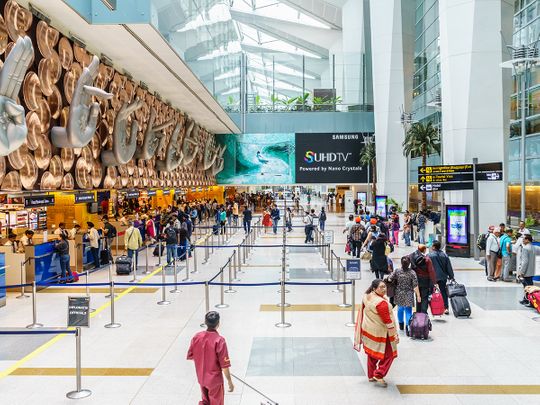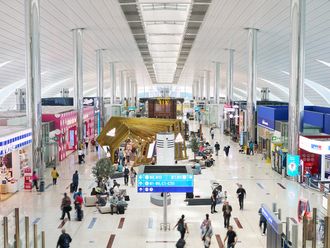
Dubai: India’s refusal to grant any more bilateral seat-sharing rights to GCC and other foreign carriers could directly impact Indian expatriates in the UAE as they may end up paying higher airfares on their trips back home.
Aviation experts say that airfares, which already skyrocket during peak travel times, could go even higher as airlines try to maximise revenue from available seats. And Indian expatriates would also have fewer flight timings and route options, leading to more travel inconveniences.
For years, Gulf carriers have been the preferred airline for Indian expatriates, given the number of passengers they carry into India via their hubs. With Indian airlines, especially Tata-owned Air India’s transformation, India seems to be restricting the growth of these carriers in India. Air India’s order of 470 new aircraft makes for an aggressive push into the international market by offering non-stop flights to long-haul destinations such as the US and Europe, a domain that GCC carriers have long held.
The debate over market access was rekindled at an aviation event in India last week when India’s Minister of Civil Aviation, Jyotiraditya Scindia, said India’s government is not looking to increase air traffic rights for the UAE and other Gulf carriers. Instead, Scindia urged Indian carriers to recapture traffic lost to Gulf and other foreign carriers by pushing airlines to order more wide-body planes to meet demand.
Dubai’s Emirates, Turkish Airlines, Kuwaiti carrier Jazeera Airways, and Qatar Airways are among those who have called for an increase in air traffic rights to and from India to meet growing demand. Analysts have said that India has exchanged approximately 135,000 seats per week with Dubai, Abu Dhabi, Sharjah and Ras Al Khaimah in separate agreements. And pre-Covid, Indian carriers were utilising around 100,000 seats per week while the UAE carriers were utilising around 115,000 seats per week.
No respite from high airfares
On the subject, Linus Benjamin Bauer, the Founder and Managing Director of Bauer Aviation Advisory (BAA), said: “If seat allotments between India and the UAE remain capped without any increase to accommodate growing demand, it could impact UAE expatriates travelling to India. The limitations in capacity may lead to higher fares, particularly during peak travel seasons, as airlines strive to maximise revenue from the available seats.”
“A balanced approach is needed to create a thriving aviation market,” said Bauer. This would involve liberalising air traffic rights, investing in airport infrastructure, and fostering competition while ensuring fair practices.
But all that seems far from reality now as budget carrier Air India Express said it would stop operating flights between UAE and peak-demand destinations such as Mumbai and Delhi as part of its summer 2023 schedule. Instead, starting March 26, Air India’s sister low-cost carrier will only fly to Tier-2 destinations in India from the UAE, said P. P. Singh, Regional Manager for the Gulf, Middle East and Africa network for both Indian carriers.
Simultaneously, the flagship carrier, Air India, will drop flights to destinations such as Goa, Indore and Kozhikode. The Sharjah-Kozhikode service operated by Air India will also no longer be there.
Use of wide-body aircraft leads to lower fares
Air India’s decision not to fly wide-body aircraft to smaller cities could impact airfares. “Wide-body aircraft typically have higher seat capacity, which allows airlines to spread costs across more passengers, potentially reducing fares. By not deploying wide-body aircraft on these routes, Air India may operate with smaller, narrow-body aircraft, which could lead to higher airfares due to the lower capacity and higher per-passenger costs,” explained Bauer.
Full-service carriers like Air India generally have higher fares than budget carriers as they offer more amenities and services to passengers. “If Air India dominates routes to smaller cities with limited LCC (low-cost carrier) competition, passengers may have fewer options for lower-priced airfares,” he added.
That being said, the impact on airfares depends on factors like market demand, competition, and overall airline strategies. “Indian aviation authorities could also encourage more competition on these routes by allowing LCCs to expand their services or incentivising other full-service carriers to enter these markets,” he added.
Is there enough space for all players?
India has one of the fastest-growing aviation markets in the world, driven by a large population, rising middle class, and increasing demand for travel. In this context, Emirates President Sir Tim Clark’s argument that there is enough space in the Indian market for all aviation players holds merit.
India has announced plans to build new airports in the country’s remotest parts while expanding capacity at metro hub airports like Delhi and Mumbai.
Also, both Indian and GCC carriers are yet to reach their full pre-COVID capacities. Though seat-sharing rights between India and Dubai have been largely exhausted, there is still massive potential in Abu Dhabi and Ras Al Khaimah, for example, said Satyendra Pandey, Managing Partner, Aairavat Technology and Transport Ventures. “Moreover, there are several weaker Indian airlines that have a portion of the bilateral seat share agreement which they are not able to use fully. This could be taken away from them and given to other players in the market,” said Pandey.
He added: “In the future, I see Indian carriers, especially Air India, making more direct flights and an exponential improvement in the product.” Pandey said that for airlines to succeed in this highly competitive market, they must either provide a better product or offer cheaper fares. “More flights from Air India Express and you have new players like Akasa Air and Wizz Air Abu Dhabi that are planning to enter the Indian market; this could mean competitive fares in the long run,” said Pandey.







